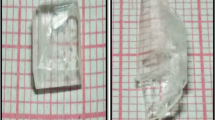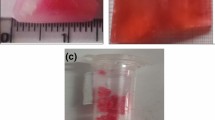Abstract
The pure glycine (GL) and Alizarin dye added glycine (GLAL) single crystals were grown for the optical devices applications. Pure and Alizarin-doped glycine crystals were grown using water as a solvent by the slow solvent evaporation method in constant temperature bath and the temperature maintained at 40°C. With the addition of alizarin (AL), the quality of the crystals, like mechanical strength and photoluminescence property, were improved. The grown crystal was characterized by various analytical techniques to investigate the different properties of the present materials. Using powder X-ray diffraction analysis, the cell parameters of pure and doped glycine crystals were found. The UV–Visible absorption spectrum shows optical transparency of the grown crystals. The presence of functional groups and vibrational modes were identified by the Fourier Transform Infrared Spectrometry (FTIR). Similar functional groups were presented in the single crystals of pure and dye-doped glycine, although few shifts were observed in the dye-doped crystals, which confirms the dye incorporation in the glycine crystals. The photoluminescence analysis identifies the multicolored emission spectra present in the material. The SHG (Second Harmonic Generation) efficiency was increased in the dye-added glycine crystals, and the dye-doped glycine crystals can be used in the fabrication of optical devices for solid-state applications. The result of LDT (Laser Damage Threshold) showed the ability of pure and dye-doped glycine crystals to withstand when LASER light passes through it. Etching analysis reveals the growth nature of the present crystals. The etch pattern represented the layered growth mechanism in the crystals. The mechanical strength of the dye-doped single crystals of glycine was increased compared to that of pure glycine crystals. This indicated that the stability of the glycine crystals was influenced by the addition of Alizarin organic dye. For different frequencies, the dielectric property of pure and dye-doped glycine crystals were measured at room temperature.











Similar content being viewed by others
Data availability
The data presented in this manuscript are available with the authors and it can be made available on by request.
References
S. Tamilselvan, X.H. Flora, A.C. Peter, M.G. Mohamed, C.K. Mahadevan, M. Vimalan, J. Madhavan, Growth and electrical properties of NLO crystals of l-asparaginium nitrate (LAsN). Arch. Appl. Sci. Res. 3(1), 235–240 (2011)
Laudise R.A., in: Ueda R., Millin J.B. (Eds.) Crystal Growth and Characterization, North-Holland Publishing Co., 1975
J.C. Brice, Crystal Growth Processes (Halsted Press/John Wiley and Sons, New York, 1986)
H.S. Nalwa, S. Miyata, Nonlinear Optics of Organic Molecules and Polymers (CRC Press Inc., New York, 1996)
B.D. Hatton, K. Landskron, W.J. Hunks, M.R. Bennett, D. Shukaris, D.D. Perovic, G.A. Ozin, Materials chemistry for low-k materials. Mater. Today, Issue 3(9), 22–31 (2006)
M. Fleck, A. Petrosyan, Difficulties in the growth and characterization of non-linear optical materials: A case study of salts of amino acids. J. Cryst. Growth 312(15), 2284–2290 (2010)
M. Fleck, P. Held, K. Schwendtner, L. Bohaty, Z. Kristallogr, New compounds of glycine with metal halogenides. Cryst. Mater. 223(3), 212–221 (2008)
D.J. Carter, M.I. Ogden, A.L. Rohl, Mechanisms of dye incorporation into potassium sulfate: computational and experimental studies. J. Phys. Chem. C 111(26), 9283–9289 (2007)
B. Kahr, R.W. Gurney, Dyeing crystals. Chem. Rev. 101, 893–951 (2001)
A. Barbon, M. Bellinazzi, J.B. Benedict, M. Brustolon, S.D. Fleming, S.-H. Jang, B. Kahr, A.L. Rohl, Luminescent probes of crystal growth: surface charge and polar axis sense in dye-doped potassium hydrogen phthalate. Angew. Chem. Issue 40(116), 5442–5445 (2004)
Yu. Velikhov, I. Pirutla, I. Ganina, M. Kolybayeva, V. Puzikov, A.N. Levchenko, Cryst. Res. Technol. 42, 27 (2007)
A. Ruby, S. Alfred Cecil Raj, Growth, spectral, optical and thermal characterization of NLO organic crystal–glycine thiourea. Int. J. ChemTech Res. 5(1), 482–490 (2013)
T.P. Srinivasan, R. Indirajith, R. Gopalakrishnan, Growth and characterization of a and g-glycine single crystals. J. Cryst. Growth 318, 762–767 (2011)
R. Bairava Ganesh, V. Kannan, R. Sathya Lakshmi, P. Ramasamy, The growth of L-Glutamic acid hydrochloride crystals by Sankaranarayanan-Ramasamy (SR) method. Mater. Lett. 61, 706–708 (2007)
M.N. Bhat, S.M. Dharmaprakash, Growth of nonlinear optical γ-glycine crystals. J. Cryst. Growth 236(1–3), 376–380 (2002)
G.C. Bhar, A.K. Chaudhury, P. Kumbhakar, Study of laser induced damage threshold and effect of inclusions in some nonlinear crystals. Appl. Surf. Sci. 161, 155–162 (2000)
N.L. Boling, M.D. Crisp, G. Dube, Laser induced surface damage. Appl. Opt. 12(4), 650–660 (1973)
G.H. Sun, G.H. Zhang, Z.H. Sun, Wang and D. Xu X. Q., Model of two-step sintering conditions for yttria-substituted zirconia powders. Mater. Chem. Phys. 126, 262–271 (2011)
V. Venkataramanan, G. Dhanaraj, H.L. Bhat, Growth mechanism, dislocation etching and mechanical properties of L-arginine phosphate and deuterated L-arginine phosphate. J Cryst Growth. 140, 336–342 (1994)
V. Sivasubramani, S.S. Mohd Anis, G.G. Hussaini, M.S. Muley, Pandian & P. Ramasamy, Bulk growth of organic non-linear optical (NLO) L-arginine 4-nitrophenolate 4-nitrophenol dihydrate (LAPP) single crystals by Sankaranarayanan-Ramasamy (SR) method. Mater. Res. Innov. 21(7), 426–433 (2017)
K.senthil, S. Kalinathan, A. Kumar, P. Aravindan, Investigation of synthesis, crystal structure and the third-order NLO properties of a new stilbazolium derivative crystal: a promosing material for nonlinear optical devices. RSC Adv. 4, 56112–56117 (2014)
G. Anandha babu, P. Ramasamy, J. Philp, Studies on the growth and physical properties of the nonlinear optical crystals 2-amino-5-nitropyridinium-toluenesulfonate.Mater. Res. Bull. 46, 631–634 (2011)
N. Boling, M. Crisp, G. Dube, Laser induced surface damage. Appl. Opt. 12, 650–660 (1973)
A.Senthil, P.Ramasamy, (2014) Investigation on the SR method growth, etching, birefringence,Laser damage threshold and thermal characterization of strontium bis (hydrogen 1. malate) hexahydrate single crystal J.Cryst.Growth 401: 200–204.
K. Sangwal, Defects in Solids (North Holland Publishing Company, Netherlands, 1987)
K. Sangwal, Etching of crystals: theory, experiment and application 1stedn. North Holland physics publishing, Amsterdam. 15, 497 (1987)
Acknowledgements
The authors are thankful to B. S. Abdur Rahman Crescent Institute of Science and Technology, Vandalur, Chennai-48, India for providing the opportunity as a post-doctoral fellow with reference number 2021PDF02 and also thank for the financial support. The authors acknowledge this institution for providing all the necessary instrumentation for this work.
Author information
Authors and Affiliations
Corresponding author
Ethics declarations
Conflict of interest
The authors declare no conflict of interest.
Ethical approval
The manuscript submitted to this journal is original and not have been published elsewhere in any form or language partially or in full.
Additional information
Publisher's Note
Springer Nature remains neutral with regard to jurisdictional claims in published maps and institutional affiliations.
Rights and permissions
About this article
Cite this article
Kanimozhi, D., Rajalakshmi, M. & Indirajith, R. Effects of Alizarin green dye in the growth, optical, mechanical and dielectric properties of glycine crystals. J Mater Sci: Mater Electron 33, 3162–3174 (2022). https://doi.org/10.1007/s10854-021-07518-6
Received:
Accepted:
Published:
Issue Date:
DOI: https://doi.org/10.1007/s10854-021-07518-6




